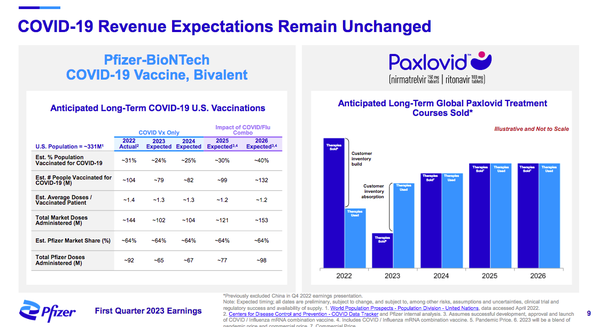With COVID Vaccine Sales Plummeting, Pfizer Looks Ahead To RSV, Flu Products
- by Les Luchter , May 2, 2023

Due to a previously projected
plummeting in sales for its COVID-19 vaccine, Pfizer on Tuesday reported first-quarter revenues of $18.3 billion -- a 29% drop year-over-year from 2022’s $25.7 billion, but above analyst
expectations.
Nonetheless, combined sales of Pfizer’s COVID-19 vaccine Comirnaty and its COVID-19 antiviral Paxlovid still accounted for $7.1 billion in the quarter, or more than a third (39%) of Pfizer’s total revenues.
Comirnaty revenues dropped to $3 billion in the quarter, down 77% YoY from 2022’s $13 billion.
Paxlovid revenues, however, actually shot up 43% YoY in the quarter -- from $1.2 billion to $4 billion -- but this was “primarily driven by favorable timing of final delivery associated with the U.S. government contract,” Pfizer said.
With Pfizer anticipating the upcoming end of such contracts for both Paxlovid and Comirnaty, the company is preparing for the release of both products into the commercial market, and, with Comirnaty, for synergies with upcoming adult RSV (respiratory syncytial virus) and flu vaccines.
advertisement
advertisement
“We have a good chance to have all three of them,” chief executive officer Albert Bourla told analysts during the company’s quarterly earnings call.
Citing this “growing and very robust respiratory portfolio,” chief commercial officer Angela Hwang said that Pfizer’s work with both its COVID and pneumonia (Prevnar) vaccines over recent years has prepared it to deal with distribution and and infrastructure, also giving the company a “great ability to educate, raise awareness and drive people to vaccination.”
Pfizer is already well underway with steps to take Comirnaty and Paxlovid “from an EUA [Emergency Use Authorization] into a full launch” so that there will be a “seamless transition,” Hwang said. “Awareness-building with physicians and patients has begun,” she explained, as well as discussions with payers (insurance companies, pharmacy benefit managers), retailers and “in the case of Paxlovid, getting telehealth and remote health capabilities set up.”
For the full year of 2023, Pfizer now expects Comirnatyrevenues of approximately $13.5 billion, down 64% from 2022 results, and Paxlovid revenues of approximately $8 billion, down 58%.
“The demand for vaccines will go down to approximately 24% of people in the U.S.,” Bourda said, the result of “less compliance with vaccination recommendations as people are tired of COVID.” And while Paxlovid demand “right now is falling,” Bourda said that come fall, “as protection against COVID drops, we expect we’ll have more infections, and that will drive more use of Paxlovid.”
Overall, largely based on the decreases from the COVID-19 drugs, Pfizer expects 2023 total revenues of $61 billion to $71 billion, which would be a decrease of from 29% to 33% compared with 2022.
Two of Pfizer’s upcoming vaccines are expected to contribute about $1 billion to those sales, although neither will even launch until the fourth quarter. One of those is Prevnar 20 for pediatric use, just approved by the Food and Drug Administration as a broader-coverage pneumonia vaccine that Hwang said will largely consist of conversions from Pfizer’s already strong pediatric Prevnar 13.
The other will be the adult RSV vaccine, which Hwang said, will “flood into the infrastructure we’ve built around COVID and (adult) Prevnar” and whose launch “comes at a great time, during the fall and the winter, when [sales of] respiratory vaccines increase.”


